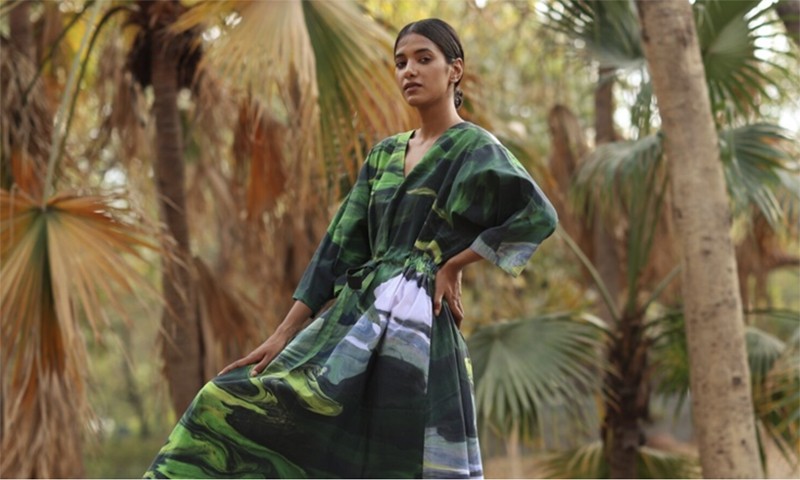 Deadstock Textile
A dress by Doodlage made from deadstock fabric. Image courtesy of Doodlage.
Deadstock Textile
A dress by Doodlage made from deadstock fabric. Image courtesy of Doodlage.
Deadstock Textile: The journey from dump yards to designer racks
Deadstock textiles, often discarded or incinerated, are being innovatively repurposed by some Indian designers into sustainable fashion, reducing environmental impact. Mongabay India correspondent Shweta Thakur Nanda reports
At the posh South Delhi studio of designer Gautam Gupta, the second floor is teeming with clients rummaging through rows of garments looking for the trendiest. Just a floor above, in a cold bare room, rolls of unsold and obsolete deadstock fabrics are ‘respectfully’ stacked in almirahs.
Once part of this euphoria on the second floor, the deadstock lying above now stands witness to a world obsessed with novelty and indulging in excess. The deadstock also holds promise of redemption for an industry known for having ecological impacts.
Usually, after languishing in warehouses, stockrooms, or backyards of fabric manufacturers and weavers, deadstock textile inventory is either incinerated or dumped in landfills, both with negative environmental impacts.
A growing number of designer accessory and fashion brands are now innovating with design to use these discarded fabrics to create responsible garments. A combination of environmental consciousness, creativity, and better business acumen is gradually driving this change.
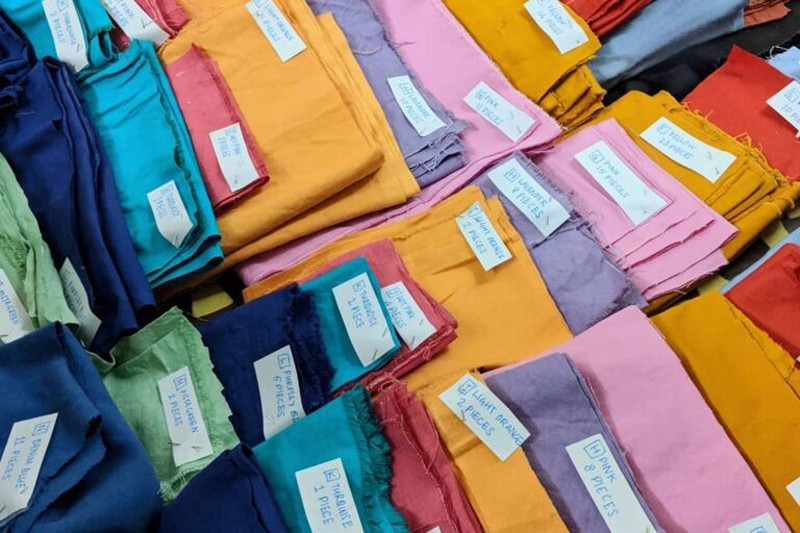
“Deadstock has emerged as an effective tool to mitigate some environmental impact of the fashion and lifestyle industry. Coming up with innovative design processes to use deadstock to create garments curbs our carbon footprint. It reduces our dependence on virgin resources as well,” says Gupta.
The designer, who regularly procures deadstock from weavers and textile godowns for his clothing lines, said the obsolete fabric piles contribute to environmental pollution. “Contrary to perception, there is a growing realisation that a good environment is a good business too.”
Apart from waste management, using deadstock also translates to water savings, as producing new fabrics, particularly cotton, is water-intensive, says Arvind Kumar, president and founder of the India Water Foundation, a non-profit think tank.
Besides, utilising deadstock materials lowers energy consumption since it bypasses energy-intensive textile manufacturing processes such as producing fibre, dyeing, and finishing. This leads to a reduced carbon footprint.
In the case of natural fibres, by not producing new materials, the need for agricultural chemicals like pesticides and fertilisers is also reduced, Kumar explains.

The Indian textile and apparel market was worth nearly $165 billion in 2022, according to government data. Growing at a compound annual growth rate of 10%, it is projected to reach $350 billion by 2030.
While the textile and apparel industry contribute well to the country’s GDP and are considered job-creating sectors, they are also noted polluters. Approximately 8.5% of global textile waste is accumulated in India every year, multiple surveys by research and consulting firms like IDH, Fashion for Good, Sattva Consulting, Reverse Resources, etc., have shown. Over 22% of this either goes to landfills or gets incinerated.
Globally, say World Bank estimates, the fashion industry is responsible for 10% of the world’s annual carbon emissions – more than all international flights and maritime shipping combined. By 2030, the fashion industry’s greenhouse gas emissions will increase by over 50%.
In such a situation, any attempt to reduce waste and make life and lifestyle responsible, is a welcome step. This attempt is reflected in the growing popularity of deadstock products as young entrepreneurs embrace novel ways to use, market, and popularise such products.
Turning constraint into creativity
In the realm of planet-positive fashion, working with deadstock is both a challenge and a design innovation opportunity.
Prakruthi Rao, co-founder of deadstock designer brand Juhu Beach Studio, says deadstock turns the traditional design process upside down. “Instead of starting with a concept, theme, and design inspiration, here the journey starts with sourcing the deadstock and then deciding on what can be created out of it,” says Mumbai-based Rao.
Deadstock textiles have their own set of constraints and characteristics, such as varying thickness and absorption properties, limited colour and texture, misprints and wrong dyeing. Fabric panels, which come in irregular dimensions and limited quantities, add to the challenge and repurposing them needs innovation.
Fabric panels are pre-cut pieces originally planned to make a specific item but remained unused. Unlike regular fabric bolts, they have peculiar dimensions, designs, or prints, which restricts the flexibility to design new garments in consistent sizes, styles, and large numbers.
Kavisha Parikh, the owner of the label Patch Over Patch, says the challenges and scope of innovation that deadstock offers thrill her and “make the manufacturing process exciting.” Gujarat-based Parikh uses an array of surface techniques such as appliqué, patchwork, cutwork, and quilting to conceal the misprinted or incorrectly dyed part. To connect two different textile patches, she creates a third fabric or lace using the crochet technique from thread deadstock.
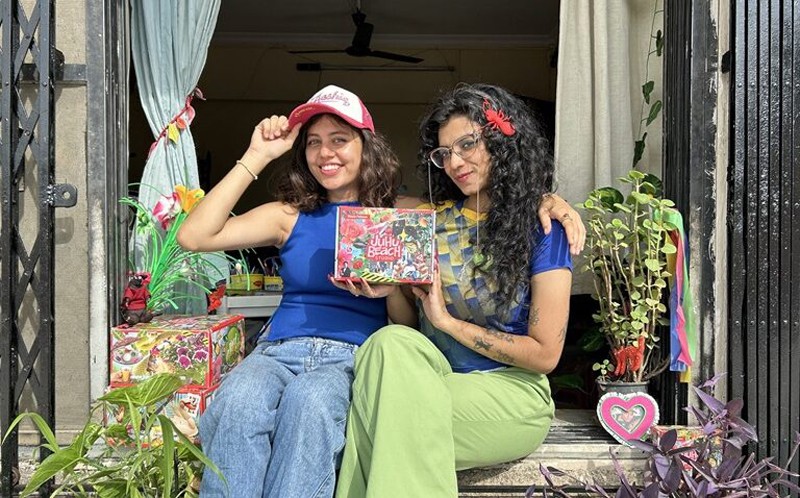
Similarly, Gupta uses hand embroidery and textile decoration techniques to embellish the wrongly dyed or misprinted part. In other cases, deadstock fabrics are used to adorn garments with patchwork and make potlis (traditional pouches with drawstrings) and latkans (decorative tassels) for blouses and lehengas.
Deadstock that is completely unusable is taken apart thread by thread and rewoven into fresh fabric, claims Gupta – a practice that clothing brands such as No Nasties and In Joy Living by designer Nisha Chauhan also employ. No Nasties sources both deadstock yarn and fabric. Artisans from Jaipur then hand-weave these into new fabrics.
Paras Arora, a co-founder of the fashion label Doodlage, says the brand initially focused on simpler and more predictable materials, such as cotton in solid colours, to navigate the challenges. “Over time, we realised that buyers appreciate the scarce nature of the raw material and recognise it as a key differentiator if the visual appeal of the garment is intact. It lends a unique appeal to deadstock products, underlines our innovation and importance of sustainability.”
The buyers’ interest due to material innovation, eco-consciousness, and social wellbeing is encouraging designers to roll out limited edition and capsule collections. These collections exude a strong sense of exclusivity and lure customers. “I don’t want my fashion choices to put any extra burden on our planet, so I try to buy clothes that are planet-positive,” says Smriti S., a filmmaker in Mumbai.
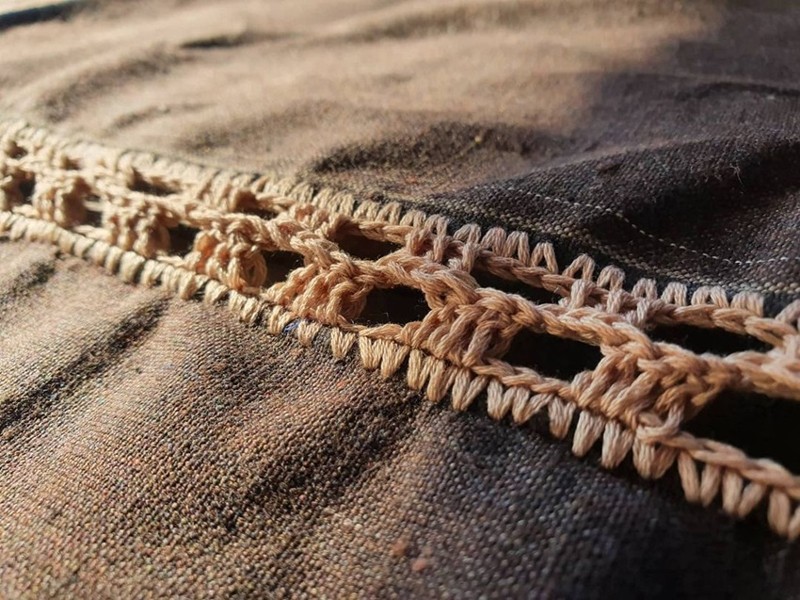
Planet friendly and business friendly
The cost of textiles, production, and transportation is constantly inching up. So, when designers work with deadstock, they reduce the input cost and capital investment in the new collection. “These savings can be used to offset other business costs like labour, machine, and logistics. It boosts our margins,” Delhi-based Gupta reasoned.
Since these are surplus and obsolete textiles, the procurement-to-production cycle has a shorter turnaround time. Smaller businesses also benefit, as they spend less on storage and inventory management.
Some argue that these collections are drawing new customers. “A segment of buyers who are upwardly mobile and eco-conscious are seeking brands that align with environmental values,” says Akanksha Kaila Akashi, founder of Refash, an e-commerce platform for deadstock garments and accessories.
Refash currently hosts 130 brands, including 90 indigenous ones, claims Akashi and informed that her platform is witnessing 20% sales growth per year.
Arora, however, says deadstock fashion is focused more on environmental gains than revenue gains. Beyond business, it is also creating social capital by benefiting the weaving and associated communities – a net positive for the circular economy.
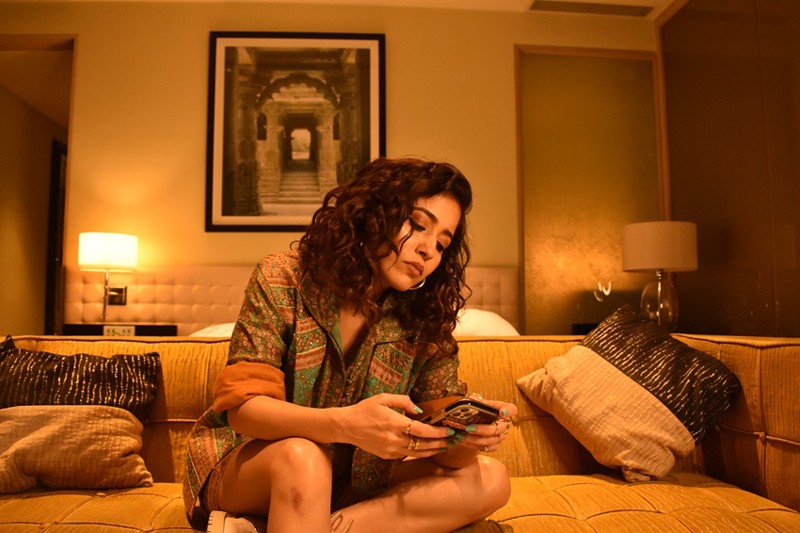
Kavisha Parikh claims to buy all her raw material (deadstock fabric) from local markets and works with artisans of Gujarat and Himachal Pradesh. “Artisans’ traditional craft is interesting, but they tend to overlook market trends and design value. This is where we step in to add value and preserve artisanry,” Parikh explains.
While the steps are well-meaning and eco-friendly, some experts warn against greenwashing. Kumar of India Water Foundation says that some brands could be capitalising on the growing consumer demand for sustainable products.
“In a consumerism-driven world, a ‘sustainable shirt’ may sound nice, but we have to go deep and address the root cause of the problem. Why produce more,” asks Mike Pandey, a well-known conservationist.
Brands and designers, however, say that while criticism about greenwashing works to maintain checks and balances, over-criticism can be demotivating and hamper sustainability efforts.
(The article was originally published in Mongabay India.)
Top Headlines
-
Environment
From Dust to Life: How Tal Chhapar Became Indias Grassland Revival Blueprint
December 18, 2025
-
Environment
From Nets to Lifelines: The Rising Whale Shark Rescue Movement Across Indias West Coast
November 29, 2025
-
Environment
Indi Setu: Wildlife on the Brink: Can We Rewild a Warming World?
October 25, 2025
-
Environment
SonaSPEED motors power NASAISRO synthetic aperture radar mission
August 01, 2025
-
Environment
How green is my city
July 01, 2025
-
Environment
India's River Dolphin: Clear And Present Danger
May 28, 2025
-
Environment
South Kashmir The costs of coexisting with predatory wildlife
May 12, 2025
-
Environment
Sariska Tiger Reserve: A maharani recognised
May 02, 2025
-
Environment
Arunachal Pradesh: Retracing a century-old biodiversity in Siang Valley
April 03, 2025
-
Environment
Toxic air and smog choke Delhi as experts at COP29 in Baku warn how dragging feet on fossil fuel reduction can cause catastrophe
November 19, 2024

